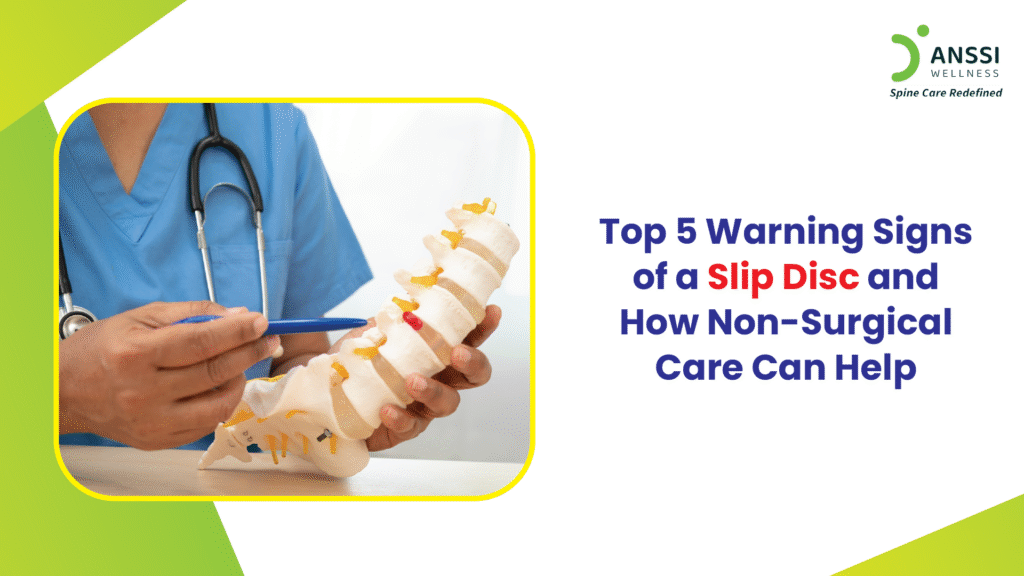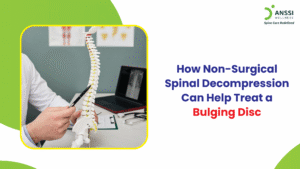A slipped disc, also known as a herniated or bulging disc, is one of the most common causes of back and neck pain today. It occurs when the soft, gel-like inner core of a spinal disc pushes through its tough outer layer, often pressing on nearby nerves. This can lead to pain, stiffness, or even loss of function if not addressed early.
Recognising the signs of a slipped disc is crucial for timely treatment, and the good news is, surgery isn’t always the answer. With the right non-surgical care, most patients can recover naturally and regain a pain-free life.
1. Persistent Back or Neck Pain
One of the earliest and most common symptoms of a slipped disc is continuous back or neck pain. This pain might feel dull and aching or sharp and shooting, depending on the location and severity of the disc bulge.
People with lumbar (lower back) disc herniation often experience pain while sitting, bending, or lifting objects. Those with cervical (neck) disc issues may feel pain radiating from the neck into the shoulders or arms.
Ignoring this discomfort and continuing regular activities can worsen the condition. The pain occurs because the slipped portion of the disc irritates or compresses spinal nerves, leading to inflammation. Early diagnosis and conservative treatment can prevent the disc from degenerating further and reduce the risk of chronic pain.
2. Radiating Pain in Arms or Legs
When a disc presses on nerves that extend from the spine, the pain often radiates along the path of those nerves. This is called referred pain, and it’s one of the clearest signs of a slipped disc.
In the lower spine, this pain is often referred to as sciatica, radiating from the lower back through the buttocks, thighs, and down one leg. In the cervical region, it may travel down one arm and into the fingers.
This radiating pain can feel like burning, sharp tingling, or even electric shocks. It’s often worse when you cough, sneeze, or sit for long periods. Such symptoms indicate that the nerve compression is significant and requires professional care to avoid long-term nerve damage.
3. Numbness or Tingling Sensations
Many people with a slipped disc notice sensations of numbness, tingling, or “pins and needles” in the affected limbs. This happens when the bulging disc interferes with normal nerve communication.
- In lumbar disc herniation, you may feel these sensations in your legs or feet.
- With a cervical disc issue, the symptoms may appear in your arms, hands, or fingers.
Numbness shouldn’t be ignored, as it’s often a sign of nerve involvement. Over time, continuous compression can reduce sensation or muscle control in that area. Seeking early non-surgical treatment can help restore nerve function and prevent lasting damage.
4. Muscle Weakness
When nerves are compressed for a prolonged period, they may stop sending proper signals to the muscles they control. As a result, you may experience weakness in certain muscles.
You might find it difficult to lift objects, maintain grip strength, or walk without feeling unstable. This weakness can progress if left untreated, impacting daily tasks and mobility.
Muscle weakness indicates that the disc problem has advanced and is beginning to affect nerve function. However, with appropriate non-surgical therapy, strength can often be restored, and nerve communication improved through gradual decompression and muscle reconditioning.
5. Limited Flexibility and Movement
Another key sign of a slipped disc is reduced flexibility. You may feel stiffness in your back or neck, find it hard to bend forward or sideways, or experience sharp pain during simple movements.
When discs bulge or herniate, the surrounding muscles tighten as a protective mechanism, further limiting mobility. This stiffness can worsen if you avoid movement due to pain, creating a cycle of immobility and weakness.
Gentle stretching, spinal alignment exercises, and decompression-based treatments can restore flexibility, relieve pressure, and help you move freely again without pain.
How Non-Surgical Care Can Help
While back surgery is sometimes necessary for severe cases, most slip disc conditions can be effectively managed through non-surgical methods. These treatments focus on relieving pressure on the affected disc, improving spinal alignment, and strengthening supportive muscles for long-term relief.
Non-Surgical Spinal Decompression Treatment
Non-surgical spinal decompression is one of the most effective modern treatments for slip disc recovery. Using an advanced decompression table, this treatment gently stretches the spine, creating negative pressure within the discs. This helps retract the herniated portion, relieving pressure on nerves and promoting the flow of oxygen, water, and nutrients to support disc healing. Spinal decompression safe, drug-free, and completely non-invasive.
Physiotherapy
Targeted physiotherapy exercises strengthen the back and neck muscles, enhance posture, and reduce the strain on spinal discs. Techniques such as core stabilisation, stretching, and muscle re-education help restore normal movement patterns and prevent recurrence.
Posture Correction and Ergonomic Adjustments
Many disc problems are aggravated by poor posture and long hours of sitting. Correcting your workstation ergonomics, using a supportive chair, keeping your screen at eye level, and maintaining a neutral spine position can significantly reduce pressure on your spine.
Lifestyle Modifications
Staying active, maintaining a healthy weight, and staying hydrated support disc health. Regular low-impact exercises such as walking, swimming, or yoga help maintain spinal flexibility and core strength.
About ANSSI:
ANSSI Wellness focuses on improving the quality of life for patients suffering from spinal issues, aiming to provide relief where other conventional treatments have failed. Through advanced Non-Surgical Spinal Decompression Treatment, ANSSI is committed to helping patients avoid surgery and recover in a safe, effective, and compassionate environment.
Connect with ANSSI Wellness on LinkedIn, Instagram, and Facebook for expert guidance.




